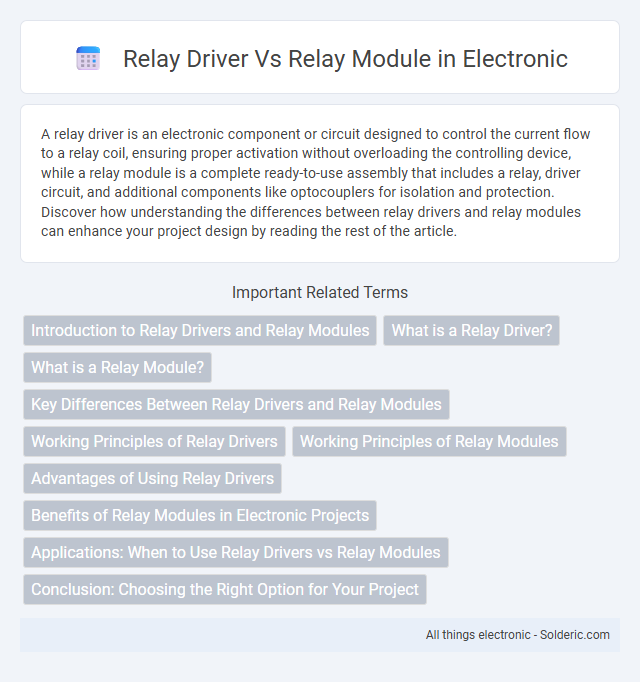A relay driver is an electronic component or circuit designed to control the current flow to a relay coil, ensuring proper activation without overloading the controlling device, while a relay module is a complete ready-to-use assembly that includes a relay, driver circuit, and additional components like optocouplers for isolation and protection. Discover how understanding the differences between relay drivers and relay modules can enhance your project design by reading the rest of the article.
Comparison Table
| Feature | Relay Driver | Relay Module |
|---|---|---|
| Definition | Electronic component that drives a relay coil with proper current and voltage | Complete board including relay, driver circuit, and protection components |
| Components | Transistor, MOSFET or IC to control relay coil | Relay, driver circuit, diode, optocoupler, and connectors |
| Ease of Use | Requires external relay and additional wiring | Plug-and-play, designed for easy integration |
| Protection Features | Depends on design, usually needs flyback diode | Includes built-in flyback diode and optocoupler for isolation |
| Control Voltage | Requires suitable voltage level for the coil driver | Usually compatible with standard logic voltage (3.3V or 5V) |
| Application | Custom or compact circuits with specific design requirements | General purpose switching with less DIY effort |
| Cost | Lower component cost but requires assembly | Higher cost due to integrated protection and convenience |
Introduction to Relay Drivers and Relay Modules
Relay drivers are electronic circuits designed to amplify low-power control signals to switch relays efficiently, ensuring proper operation without damaging sensitive components. Relay modules integrate relay drivers, relays, and additional safety features like protection diodes and optocouplers into a single unit for easy interfacing with microcontrollers and other control systems. Understanding the difference between a relay driver and a relay module helps you choose the right component for reliable switching tasks in your electronic projects.
What is a Relay Driver?
A relay driver is an electronic component or circuit designed to control the high current required to operate a relay coil, acting as an interface between low-power microcontrollers and relays. It typically consists of transistors, MOSFETs, or integrated driver ICs that amplify the control signal to safely switch the relay. Relay drivers ensure reliable activation of relays by providing the necessary current and voltage levels without damaging the controlling device.
What is a Relay Module?
A relay module is an integrated circuit that contains one or more relays combined with necessary components such as transistors, diodes, and resistors to enable easy interfacing with microcontrollers and other low-voltage control systems. Unlike a standalone relay driver, a relay module provides built-in protection and simplifies the process of switching high-voltage loads safely and efficiently. When you use a relay module, you benefit from a ready-to-use solution that ensures reliable electrical isolation and control without needing additional external components.
Key Differences Between Relay Drivers and Relay Modules
Relay drivers serve as intermediate circuits that amplify control signals to activate relays, primarily handling electrical current requirements. Relay modules, on the other hand, integrate relay drivers, relays, and protective components like diodes and resistors into a single, ready-to-use unit for easier implementation. The key differences include complexity, where relay drivers require additional circuitry, versus relay modules offering plug-and-play functionality with enhanced protection and convenience.
Working Principles of Relay Drivers
Relay drivers function by amplifying low-current control signals from microcontrollers or logic circuits to energize the relay coil, enabling the relay to switch high-power loads safely. These drivers often incorporate transistors, MOSFETs, or optocouplers to provide isolation and sufficient current amplification, ensuring reliable activation of the relay. Unlike relay modules that combine the coil and driver circuitry, standalone relay drivers focus solely on signal amplification and protection for the relay coil.
Working Principles of Relay Modules
Relay modules operate by using an electromagnetic coil to open or close the internal switch, allowing low-voltage circuits to control high-voltage devices safely. These modules often include additional components like transistors, diodes, and optocouplers to provide isolation and protect your microcontroller or control system from voltage spikes. Understanding the working principles of relay modules can help you effectively integrate them into automation or control projects for reliable switching performance.
Advantages of Using Relay Drivers
Relay drivers improve relay performance by providing the necessary current and voltage to energize the relay coil reliably, preventing microcontroller damage. They enable isolation between low-voltage control circuits and high-voltage loads, enhancing system safety and stability. Using relay drivers also allows for easier integration of multiple relays and reduces power consumption in control systems.
Benefits of Relay Modules in Electronic Projects
Relay modules offer enhanced convenience and safety for electronic projects by integrating necessary components such as flyback diodes, transistors, and resistors, which protect microcontrollers from voltage spikes. These modules simplify circuit assembly and improve reliability by providing standardized connectors and isolation between control signals and high-power loads. Their plug-and-play design accelerates prototyping and reduces wiring errors, making them ideal for both beginners and advanced users in automation and control systems.
Applications: When to Use Relay Drivers vs Relay Modules
Relay drivers are ideal for applications requiring precise control of individual relays, such as in microcontroller-based projects where you need to amplify low current signals to switch high-power devices. Relay modules are best suited for plug-and-play scenarios involving multiple relays, providing built-in protection and easy interfacing for remote control or automation systems. Your choice depends on whether your project demands simple relay activation or a more integrated, user-friendly solution with added safety features.
Conclusion: Choosing the Right Option for Your Project
Relay drivers provide precise control over individual relays, ideal for projects requiring direct hardware management and custom circuit integration. Relay modules offer a simpler, plug-and-play solution with built-in protection components and ready-to-use circuitry, making them suitable for rapid prototyping and less complex applications. Selecting the right option depends on your project's complexity, required control precision, and integration convenience.
Relay driver vs relay module Infographic

 solderic.com
solderic.com